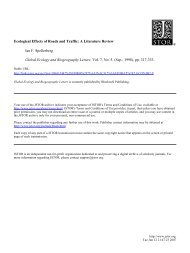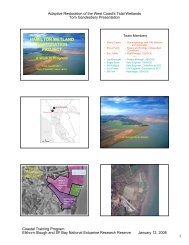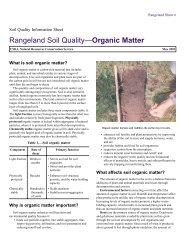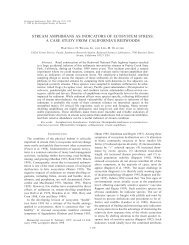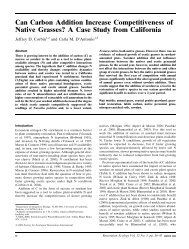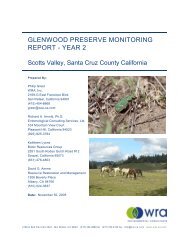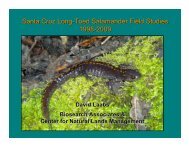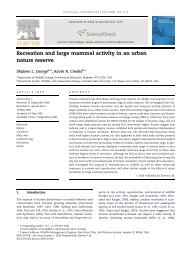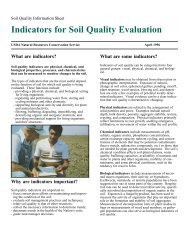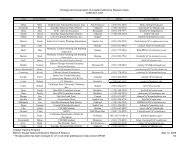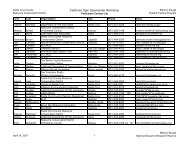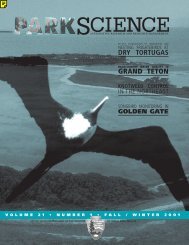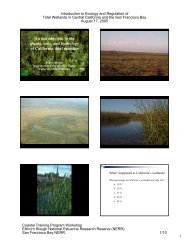BREEDING <strong>BIRD</strong> CENSUS: 2007+; Western Scrub-Jay, + (1N,3FL); Golden-crownedKinglet, +; Song Sparrow, +. Total: 20 species; 39.5territories (195/40 ha). Visitors: None listed.Remarks: The total number of territories (39.5) wasdown 8% from 2006 (43.0). Minor declines in thedensities of several species were responsible for theoverall decline, which was observed despite somenotable increases in a couple of species. Wilson’sWarbler increased from 1.5 to 4.5 territories, andSwainson’s Thrush increased from 1.0 to 2.5territories. Band-tailed Pigeon and Mourning Dovewere present in 2006 but not in 2007. Acknowledgments:We thank the Point Reyes NationalSeashore for their cooperation. This is PRBOcontribution No. 1758.21. DISTURBED COASTAL SCRUB AMATORRAL PERTURBADO ASCOTT JENNINGS & ELIZABETH PORZIGPRBO Conservation Science3820 Cypress Drive #11Petaluma CA 94954Location: California; Marin Co.; Bolinas; PalomarinField Station; 37°55'N, 122°45'W; Bolinas Quadrangle,USGS. Continuity: Established 1972; 33 yr. Size: 4.7ha. Description of Plot: See Am. Birds 26:987–988(1972). Succession from coastal scrub to Douglas-fir(Pseudotsuga menziesii) forest continues across mostareas of the plot. Forest is progressing across the plotroughly from northeast to southwest. Weather: Meanstart temp., 13.0°C (range 8–23°C). The bioyear rainfalltotal (1 July 2006–30 June 2007) was 595.7 mm. The1976–2007 mean bioyear rainfall was 869.2 mm. Thebreeding season rainfall (1 April–31 July) was 79.5mm. Coverage: 216.0 h; 80 visits (32 sunrise, 0 sunset).2007. Census: Wrentit, 7.5 (64; 11N,28FL); SongSparrow, 4.0 (34; 5N,12FL); Bewick's Wren, 3.0 (26);Wilson’s Warbler, 3.0; Spotted Towhee, 3.0 (3N,4FL);Anna's Hummingbird, 2.5; Swainson's Thrush, 2.0;California Quail, 1.5; Orange-crowned Warbler, 1.5;Purple Finch, 1.5; American Goldfinch, 1.5 (1N);Allen's Hummingbird, 1.0; Steller's Jay, 1.0; ChestnutbackedChickadee, 1.0; Golden-crowned Kinglet, 1.0;Band-tailed Pigeon, 0.5; Mourning Dove, 0.5; NorthernFlicker, 0.5; Hutton’s Vireo, 0.5; Bushtit, 0.5; AmericanRobin, 0.5; Red-tailed Hawk, +; Downy Woodpecker,+; Pacific-slope Flycatcher, +; Warbling Vireo, +;Western Scrub-Jay, +; Dark-eyed Junco, +; BrownheadedCowbird, +. Total: 28 species; 38.0 territories(323/40 ha). Visitors: None listed. Remarks: Twoobservers worked separately to monitor the plot thisyear. Total visits and number of hours spent censusingwere summed for both observers, thus these numbersare higher than in recent years. The total number ofterritories increased 17% from 32.5 in 2006 to 38.0 thisyear. This increase appears to be the result of minorincreases in the densities of the majority of speciespresent on the plot; no species showed a large changein density. European Starling, California Towhee, andHouse Finch were observed in 2006 but not in 2007.None of these species showed numbers greater than0.5 territories in 2006, however. Acknowledgments:We thank the Point Reyes National Seashore for theircooperation. This is PRBO contribution No. 1756.22. DISTURBED COASTAL SCRUB BMATORRAL PERTURBADO BIRENE KOULOURIS & SCOTT JENNINGSPRBO Conservation Science3820 Cypress Drive #11Petaluma CA 94954Location: California; Marin Co.; Bolinas; PalomarinField Station; 37°55'N, 122°46'W; Bolinas Quadrangle,USGS. Continuity: Established 1971; 33 yr. Size: 8.1ha. Description of Plot: See Am. Birds 25:1002–1003(1971) and J. Field Ornithol. 66(Suppl.):104 (1995). Theplant community continues to change from coastalscrub to Douglas-fir (Pseudotsuga menziesii) forest.This succession is progressing generally from east towest across the plot. The western portion of the plot islargely coastal scrub with isolated stands of trees; theeastern portion is primarily dense fir forest rangingfrom 6–10 m high with scattered patches of grass andcoastal scrub. Weather: Mean start temp., 13.0°C(range 8–23°C). The bioyear rainfall total (1 July2006–30 June 2007) was 595.7 mm. The 1976–2007mean bioyear rainfall was 869.2 mm. The breedingseason rainfall (1 April–31 July) was 79.5 mm.Coverage: 152.2 h; 64 visits (16 sunrise, 0 sunset). 2007.Census: Wrentit, 8.0 (40; 5N,5FL); Song Sparrow, 7.5(37; 7N,21FL); Swainson's Thrush, 4.5 (22); WinterWren, 4.0 (20); Wilson's Warbler, 4.0; Bewick's Wren,2.5; American Goldfinch, 2.5 (7N); Anna'sHummingbird, 2.0; Orange-crowned Warbler, 2.0;Purple Finch, 2.0; Spotted Towhee, 1.5; Hutton’s Vireo,0.5; Western Scrub-Jay, 0.5; Chestnut-backedChickadee, 0.5; Bushtit, 0.5; American Robin, 0.5; RedtailedHawk, +; Mourning Dove, +; Northern Flicker,+; Warbling Vireo, +; Steller’s Jay, +; Golden-crownedKinglet, +; California Towhee, +; Brown-headedCowbird, +. Total: 24 species; 43.0 territories (212/40ha). Visitors: None listed. Remarks: The total numberof territories decreased 18% from 52.5 in 2006 to 43.0this year. The majority of species showed moderatedecreases in density of 20–50%. Wilson’s Warbler andSwainson’s Thrush both increased in density, however,and Western Scrub-Jay and Anna’s Hummingbirdremained constant. California Quail, Olive-sidedFlycatcher, and Allen’s Hummingbird were present in2006 but not in 2007. Acknowledgments: We thank thePoint Reyes National Seashore for their cooperation.This is PRBO contribution No. 1757.[124]
Bird Populations 10:125-135© The Institute for Bird Populations 2010BREEDING <strong>BIRD</strong> CENSUS: 20081. MIXED HARDWOOD POLETIMBERBOSQUE MIXTO MADERERODAVID ROSGENWhite Memorial Conservation CenterP.O. Box 368Litchfield CT 06759Site Number: CT1265009. Location: Connecticut;Litchfield Co.; Litchfield; White MemorialFoundation–Wheeler Hill; 41°42'N, 73°13'W; LitchfieldQuadrangle, USGS. Continuity: Established 1965; 43yr. Size: 8.5 ha. Description of Plot: See Aud. FieldNotes 19:609–610 (1965), J. Field Ornithol. 64(Suppl.):36(1993), and Bird Populations 8:125 (2007). Non-nativeshrubs and vines are continuing to take over this plot,and over-browsing of native vegetation by whitetaileddeer was very evident again this year. Weather:Mean start temp., 22.0°C (range 17–27°C). The weatherthroughout all of 2008 was much wetter than normalin Connecticut. The months of May and June sawmore wet days than dry ones. It was very conducive tovegetation growth, and it helped produce anabundance of seeds, berries, and insects as the seasonprogressed. Rainfall was above average in May with17 wet days producing a total of 8.4 cm of rain. Thenumber of wet days decreased slightly in June to 16,but the amount of precipitation increased significantlyto 14.3 cm. That’s well-above average. In July, therewere 13 wet days that produced a total of 15.4 cm ofrain. That’s a little above average. May’s meantemperature was 12.3°C, which is a little belowaverage. The mean temperature in June was 19.3°C,which is close to average. In July, the meantemperature was 21.9°C, which is close to average.Source: White Memorial Foundation’s weatherstation. Coverage: 22.0 h; 10 visits (0 sunrise, 4 sunset);8, 21, 30 May; 12, 19, 30 June; 11, 18, 25, 31 July; 2008.Maximum number of observers/visit, 3. Census:Veery, 14.0 (66; 6FL); Gray Catbird, 13.5 (64; 5N,21FL);Ovenbird, 13.0 (61; 1N,11FL); Red-eyed Vireo, 12.5 (59;1N,7FL); Common Yellowthroat, 10.0 (47; 10FL);American Redstart, 9.0 (42; 3N,19FL); Eastern Towhee,9.0 (11FL); Wood Thrush, 4.5 (21; 2FL); NorthernCardinal, 4.5 (1N,10FL); Chestnut-sided Warbler, 4.0(19; 8FL); Black-capped Chickadee, 3.5 (16; 1N,10FL);Tufted Titmouse, 3.5 (16FL); Yellow Warbler, 3.5(2N,9FL); American Robin, 3.0 (14; 2N,9FL); Blackand-whiteWarbler, 2.5 (3FL); Scarlet Tanager, 2.0;Common Grackle, 2.0 (2N,8FL); Baltimore Oriole, 2.0(1N,5FL); American Goldfinch, 2.0 (2FL); EasternWood-Pewee, 1.5; Blue Jay, 1.5 (1FL); American Crow,1.5 (2FL); Cedar Waxwing, 1.5 (2FL); Mourning Dove,1.0 (2FL); Downy Woodpecker, 1.0 (3FL); WhitebreastedNuthatch, 1.0 (5FL); House Wren, 1.0(1N,4FL); Chipping Sparrow, 1.0 (3FL); Song Sparrow,1.0 (1N,4FL); Rose-breasted Grosbeak, 1.0 (1FL);House Finch, 1.0 (2FL); Wild Turkey, 0.5; RubythroatedHummingbird, 0.5; Red-bellied Woodpecker,0.5 (2FL); Great Crested Flycatcher, 0.5; Blue-wingedWarbler, 0.5; Red-winged Blackbird, 0.5; Barred Owl,+; Yellow-bellied Sapsucker, +; Hairy Woodpecker, +;Northern Flicker, +; Least Flycatcher, +; EasternKingbird, +; Yellow-throated Vireo, +; Warbling Vireo,+; Brown-headed Cowbird, +; Purple Finch, +. Total:47 species; 135.0 territories (635/40 ha). Visitors:Pileated Woodpecker. Remarks: The number ofspecies exhibiting breeding evidence in this plotdecreased to 47 this year, from 48 last year, 50 in 2006,and 51 in 2005. This year’s number, however, is on parwith the average of the previous 10 years. The totalnumber of territories decreased to 135.0 this year. Lastyear, 141.0 were tallied here. The year before we found132.0, and in 2005 we found 124.5. The average of theprevious 10 years is 119.5 territories, so 2008 remainedwell-above average. Every year since 2000 hasproduced more than 108 territories. The mostabundant species this year was Veery with 14.0territories. Last year, they were the second mostabundant species but had 14.5 territories. In 2006, theywere also in second place with 12.0 territories. Thesecond most abundant species this year was GrayCatbird with 13.5 territories. Last year, they were themost abundant species with 15.5 territories. In 2006,they were the fourth most abundant species with 11.0territories. Ovenbird has been the third most abundantspecies here for the past few years, and this year wasno exception with 13.0 territories. Last year, it had13.5, and in 2006, it had 11.5 territories. The recentpopulation fluctuations of these three species are notsignificant, and they can be considered relativelystable. Least Flycatcher and Chipping Sparrow werefound this year but not last year. Species found lastyear but not this year included Pileated Woodpecker(one-time visitor this year), Eastern Phoebe, and Blue-[125]
- Page 1 and 2:
BIRD POPULATIONSA journal of global
- Page 3 and 4:
BIRD POPULATIONSA journal of global
- Page 6 and 7:
ROBERT L. WILKERSON AND RODNEY B. S
- Page 8 and 9:
ROBERT L. WILKERSON AND RODNEY B. S
- Page 10 and 11:
ROBERT L. WILKERSON AND RODNEY B. S
- Page 12 and 13:
ROBERT L. WILKERSON AND RODNEY B. S
- Page 14 and 15:
ROBERT L. WILKERSON AND RODNEY B. S
- Page 16 and 17:
ROBERT L. WILKERSON AND RODNEY B. S
- Page 18 and 19:
ROBERT L. WILKERSON AND RODNEY B. S
- Page 20 and 21:
ROBERT L. WILKERSON AND RODNEY B. S
- Page 22 and 23:
ROBERT L. WILKERSON AND RODNEY B. S
- Page 24 and 25:
ROBERT L. WILKERSON AND RODNEY B. S
- Page 26 and 27:
ROBERT L. WILKERSON AND RODNEY B. S
- Page 28 and 29:
ROBERT L. WILKERSON AND RODNEY B. S
- Page 30 and 31:
ROBERT L. WILKERSON AND RODNEY B. S
- Page 32 and 33:
ROBERT L. WILKERSON AND RODNEY B. S
- Page 34 and 35:
ROBERT L. WILKERSON AND RODNEY B. S
- Page 36 and 37:
ROBERT L. WILKERSON AND RODNEY B. S
- Page 38 and 39:
ROBERT L. WILKERSON AND RODNEY B. S
- Page 40 and 41:
NIRANJAN DAS AND SUJATA DEORIincluy
- Page 42 and 43:
NIRANJAN DAS AND SUJATA DEORIprovid
- Page 44 and 45:
NIRANJAN DAS AND SUJATA DEORIpopula
- Page 46 and 47:
NIRANJAN DAS AND SUJATA DEORITABLE
- Page 48 and 49:
NIRANJAN DAS AND SUJATA DEORITABLE
- Page 50 and 51:
NIRANJAN DAS AND SUJATA DEORITABLE
- Page 52 and 53:
NIRANJAN DAS AND SUJATA DEORITABLE
- Page 54 and 55:
NIRANJAN DAS AND SUJATA DEORITABLE
- Page 56 and 57:
NIRANJAN DAS AND SUJATA DEORITABLE
- Page 58 and 59:
Bird Populations 10:56-64© The Ins
- Page 60 and 61:
WETLAND BIRDS OF GHANAAvicennia afr
- Page 62 and 63:
WETLAND BIRDS OF GHANATABLE 1. Data
- Page 64 and 65:
WETLAND BIRDS OF GHANATABLE 2: Esti
- Page 66 and 67:
WETLAND BIRDS OF GHANAATTUQUAYEFIO,
- Page 68 and 69:
JANNIK HANSEN, LARS HOLST HANSEN, N
- Page 70 and 71:
JANNIK HANSEN, LARS HOLST HANSEN, N
- Page 72 and 73:
JANNIK HANSEN, LARS HOLST HANSEN, N
- Page 74 and 75:
JANNIK HANSEN, LARS HOLST HANSEN, N
- Page 76 and 77: JANNIK HANSEN, LARS HOLST HANSEN, N
- Page 78 and 79: JANNIK HANSEN, LARS HOLST HANSEN, N
- Page 80 and 81: JANNIK HANSEN, LARS HOLST HANSEN, N
- Page 82 and 83: JANNIK HANSEN, LARS HOLST HANSEN, N
- Page 84 and 85: JANNIK HANSEN, LARS HOLST HANSEN, N
- Page 86 and 87: JANNIK HANSEN, LARS HOLST HANSEN, N
- Page 88 and 89: JANNIK HANSEN, LARS HOLST HANSEN, N
- Page 90 and 91: BIRD POPULATIONSA journal of global
- Page 92 and 93: Bird Populations 10:90-109© The In
- Page 94 and 95: DAVID J. ZIOLKOWSKI JR., KEITH L. P
- Page 96 and 97: DAVID J. ZIOLKOWSKI JR., KEITH L. P
- Page 98 and 99: DAVID J. ZIOLKOWSKI JR., KEITH L. P
- Page 100 and 101: DAVID J. ZIOLKOWSKI JR., KEITH L. P
- Page 102 and 103: DAVID J. ZIOLKOWSKI JR., KEITH L. P
- Page 104 and 105: DAVID J. ZIOLKOWSKI JR., KEITH L. P
- Page 106 and 107: DAVID J. ZIOLKOWSKI JR., KEITH L. P
- Page 108 and 109: DAVID J. ZIOLKOWSKI JR., KEITH L. P
- Page 110 and 111: DAVID J. ZIOLKOWSKI JR., KEITH L. P
- Page 112 and 113: Bird Populations 10:110-113© The I
- Page 114 and 115: THE 2007 AND 2008 NORTH AMERICAN BR
- Page 116 and 117: Bird Populations 10:114-124© The I
- Page 118 and 119: BREEDING BIRD CENSUS: 2007on the pl
- Page 120 and 121: BREEDING BIRD CENSUS: 2007May, with
- Page 122 and 123: BREEDING BIRD CENSUS: 2007Remarks:
- Page 124 and 125: BREEDING BIRD CENSUS: 200717. PITCH
- Page 128 and 129: BREEDING BIRD CENSUS: 2008gray Gnat
- Page 130 and 131: BREEDING BIRD CENSUS: 2008Warbler,
- Page 132 and 133: BREEDING BIRD CENSUS: 2008Source: W
- Page 134 and 135: BREEDING BIRD CENSUS: 2008Spotted T
- Page 136 and 137: BREEDING BIRD CENSUS: 2008precipita
- Page 138 and 139: Bird Populations 10© The Institute
- Page 140 and 141: IS AVIAN BREEDING SUCCESS WEATHERIN
- Page 142 and 143: IS AVIAN BREEDING SUCCESS WEATHERIN
- Page 144 and 145: DAVE LEECH AND CARL BARIMOREFlycatc
- Page 146 and 147: Bird Populations 10:143-145Reprinte
- Page 148 and 149: WOODPIGEON JOINS THE GARDEN PREMIER
- Page 150 and 151: CHANGING THE GUARD AT UK BIRDTABLES
- Page 152 and 153: Bird Populations is an entirely ele
- Page 154: BIRD POPULATIONSA journal of global



